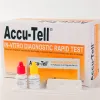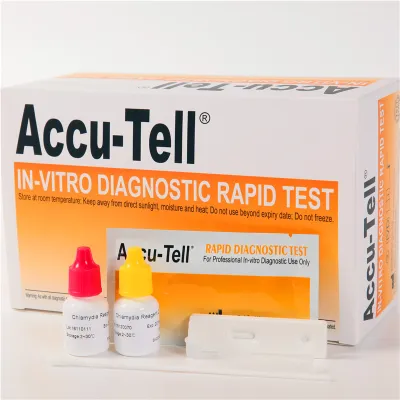Accu-Tell® Chlamydia Rapid Test Cassette (Swab/Urine)
Product Description
CATALOG
Product Name | Specimen | Catalog No. | Quantity per box | Certificate |
Chlamydia Cassette | Swab/Urine | ABT-STD-B18 | 20T |
KEY POINTS
Detection for: Chlamydia antigen in female cervical swab, male urethral swab and male urine specimens.
Specimen volume: Refer to the test procedure
Reading time: 10 minutes
For Female Cervical Swab Specimens:
Relative Sensitivity: 90% (76.3%-97.2%)*
Relative Specificity: 96.5% (91.3%-99.0%)*
Relative accuracy: 94.8% (90.0%-97.8%)*
For Male Urethral Swab Specimens:
Relative Sensitivity: 80.9% (66.7%-90.9%)*
Relative Specificity: 94.3% (88.1%-97.9%)
Relative accuracy: 90.2% (84.3%-94.4%)*
For Male Urine Specimens:
Relative Sensitivity: 92.3% (74.9%-99.1%)*
Relative Specificity: >99.9% (93.6%-100%)*
Relative Accuracy: 97.2% (90.2%-99.7%)*
INTRODUCTION
Chlamydia trachomatis is the most common cause of sexually transmitted venereal infection in the world. It is composed of elementary bodies (the infectious form) and reticulate or inclusion bodies (the replicating form). Chlamydia trachomatis has both a high prevalence and asymptomatic carriage rate, with frequent serious complications in both women and neonates. Complications of Chlamydia infection in women include cervicitis, urethritis, endometritis, pelvic inflammatory disease (PID) and increased incidence of ectopic pregnancy and infertility.
INTENDED USE
ACCU-TELL® Chlamydia Rapid Test Cassette (Swab/Urine) is a rapid chromatographic immunoassay for the qualitative detection of Chlamydia trachomatis in female cervical swab, male urethral swab and male urine specimens to aid in the diagnosis of Chlamydia infection.
TEST PROCEDURE
1. Remove the test cassette from the seal pouch and use it within one hour. Best result will be obtained if the test is performed immediately after opening the foil pouch.
2. Extract the Chlamydia antigen according to the specimen type.
For Female Cervical or Male Urethral Swab Specimen:
1.) Hold the reagent 1 bottle vertically and add 5 drops of reagent 1 (approx. 300μl) to the extraction tube. Reagent 1 is colorless. Immediately insert the swab, compress the bottom of tube and rotate swab 15 times. Let stand for 2 minutes.
2.) Hold the reagent 2 bottle vertically add 6 drops of reagent 2 (approx. 250μl) to the extraction tube. The solution would turn turbid. Compress the bottle of tube and rotate the swab 15 times until the solution turn clear with a slight green or blue tint. If the swab is bloody, the color will turn yellow or brown. Let stand 1 minute.
3.) Press the swab against the side of tube and withdraw the swab while squeezing the tube. Keep as much liquid in the tube as possible. Fit the dropper tip on top of extraction tube.
For Male Urine Specimens:
1.) Hold the reagent 2 bottle vertically and add 6 drops of (approx. 250μl) reagent 2 to the urine pellet in the centrifuge tube, then shake the tube vigorously until the suspension is homogeneous.
2.) Transfer all the solution in the centrifuge tube to an extraction tube. Let stand for 1 minute. Hold the reagent 1 bottle upright and add 5 drops of (approx. 300μl) reagent 1 to the extraction tube. Vertex or tap the bottom of the tube to mix the solution. Let stand for 2 minutes.
Fit the dropper tip on top of the extraction tube.
3. Place the test cassette on a clean and level surface. Add 3 full drops of the extracted solution (approx. 100μl) to the specimen well of the test cassette, then start the timer. Avoid trapping air bubbles in the specimen well.
4. Wait for the color to appear. Read the result at 10 minutes; do not interpret the result after 20 minutes.
PERFORMANCE CHARACTERISTICS
Sensitivity
ACCU-TELL® Chlamydia Rapid Test Cassette (Swab/Urine) has been evaluated with specimens obtained from patients of STD clinics. PCR is used as the reference method for ACCU-TELL® Chlamydia Rapid Test Cassette (Swab/Urine). Specimens were considered positive if PCR indicated a positive result. Specimens were considered negative if PCR indicated a negative result. The results show that ACCU-TELL® Chlamydia Rapid Test Cassette (Swab/Urine) has a high sensitivity relative to PCR.
Specificity
ACCU-TELL® Chlamydia Rapid Test Cassette (Swab/Urine) uses an antibody that is highly specific for Chlamydia antigen in female cervical swab, male urethral swab and male urine specimens. The results show that ACCU-TELL® Chlamydia Rapid Test Cassette (Swab/Urine) has a high specificity relative to PCR.
For Female Cervical Swab Specimens
Method | PCR | Total Results | ||
ACCU-TELL® Chlamydia Rapid Test Cassette (Swab/Urine) | Results | Positive | Negative | |
Positive | 36 | 4 | 40 | |
Negative | 4 | 110 | 114 | |
Total Results | 40 | 114 | 154 | |
Relative Sensitivity: 90% (76.3%-97.2%)*
Relative Specificity: 96.5% (91.3%-99.0%)*
Relative accuracy: 94.8% (90.0%-97.8%)*
*95% Confidence Intervals
For Male Urethral Swab Specimens
Method | PCR | Total Results | ||
ACCU-TELL® Chlamydia Rapid Test Cassette (Swab/Urine) | Results | Positive | Negative | |
Positive | 38 | 6 | 44 | |
Negative | 9 | 100 | 109 | |
Total Results | 47 | 106 | 153 | |
Relative Sensitivity: 80.9% (66.7%-90.9%)*
Relative Specificity: 94.3% (88.1%-97.9%)
Relative accuracy: 90.2% (84.3%-94.4%)*
*95% Confidence Intervals
For Male Urine Specimens
Method | PCR | Total Results | ||
ACCU-TELL® Chlamydia Rapid Test Cassette (Swab/Urine) | Results | Positive | Negative | |
Positive | 24 | 0 | 24 | |
Negative | 2 | 45 | 47 | |
Total Results | 26 | 45 | 71 | |
Relative Sensitivity: 92.3% (74.9%-99.1%)*
Relative Specificity: >99.9% (93.6%-100%)*
Relative Accuracy: 97.2% (90.2%-99.7%)*
*95% Confidence Intervals
Cross Reactivity
The antibody used in ACCU-TELL® Chlamydia Rapid Test Cassette (Swab/Urine) has been shown to detect all known Chlamydia serovars. Chlamydia psittasi and Chlamydia pneumoniae strains have been tested with ACCU-TELL® Chlamydia Rapid Test Cassette (Swab/Urine), and were shown to cross react when tested in suspensions of 109 Colony Forming Units (CFU)/ml. Cross reactivity with other organisms has been studied using suspensions of 109 CFU/ml. The following organisms were found negative when tested with ACCU-TELL® Chlamydia Rapid Test Cassette (Swab/Urine):
Acinetobacter calcoaceticus | Pseudomona aeruginosa | Proteus mirabilis |
Acinetobacter spp | Neisseria meningitides | Neisseria gonnorhea |
Enterococcus faecalis | Salmonella choleraesius | Group B/C Streptococcus |
Enterococcus faecium | Candida albicans | Hemophilus influenzae |
Staphylococcus aureus | Proteus vulgaris | Branhamella catarrhalis |
Klebsiella pneumoniae | Gardnerella vaginalis |
LIMITATIONS
1. ACCU-TELL® Chlamydia Rapid Test Cassette (Swab/Urine) is for in vitro diagnostic use only. This test should be used for the detection of Chlamydia antigen from female cervical swab, male urethral swab and male urine specimens. Neither the quantitative value nor the rate of increase in Chlamydia antigen concentration can be determined by this qualitative test.
2. This test will only indicate the presence of Chlamydia antigen in specimens from both viable and non-viable Chlamydia. Performance with specimens other than female cervical swabs, male urethral swabs and male urine has not been assessed.
3. Detection of Chlamydia is dependent on the number of organisms present in the specimen. This can be affected by specimen collection methods and patient factors such as age, history of Sexually Transmitted Diseases (STDs), presence of symptoms, etc. The minimum detection level of this test may vary according to serovar. Therefore, the test results should be interpreted in conjunction with other laboratory and clinical data available to the physician.
4. Therapeutic failure or success cannot be determined as antigen may persist following appropriate antimicrobial therapy.
5. Excessive blood on the swab may cause false positive results.
Note: The above information is for reference use only. Please refer to the product insert provided with the products before use.












